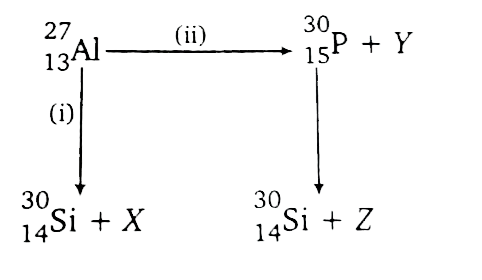Complete Solutions to JEE Main And Advanced of chapter NUCLEAR CHEMISTRY of Class 12 book with complete answers and questions
| Class 12 | CHEMISTRY |
| Chapter | NUCLEAR CHEMISTRY |
| IIT-JEE PREVIOUS YEAR | JEE Main And Advanced |
| Number Of Questions | 33 |
| Academic Year | 2023-24 |
Bombardment of aluminium by `alpha-"particle"` leads to its artificial disintegration in two ways, `(i) and (ii)` as shown.
Products `X,Y` and `Z` respectively, are
 03:20View Solution
03:20View SolutionA positron is emitted from `._(11)Na^(23)` . The ratio of the atomic mass and atomic number of the resulting nuclide is
01:26View Solution`.^(23)` Na is the more stable isotope of Na. Find out the process by which `._(11)^(24)` Na can undergo radioactive decay.
02:15View SolutionThe number of neutrons accompanying the formation of `._(54)Xe^(139)` and `._(38)Sr^(94)` from the absorption of a slow neutron by `._(92)U^(235)`, followed by nuclear fission is
02:09View Solution`._(13)Al^(27)` is a stable isotope. `._(13)Al^(29)` is expected to disintegrate by
02:46View SolutionThe radiations from a naturally occuring radioactive substance as seen after deflection by a magnetic field in one direction are
a.Only `alpha`-rays b. Only `beta`-rays
c. Both `alpha`-and `beta-`rays d. Either `alpha`-or `beta`-rays01:55View SolutionAn isotope of `Ge'_(32)^(76)` is
01:31View SolutionIf uranium `(` mass number 238 and atomic number 92`)` emits an `alpha-`paticle, the produc has mass number and atomic number
01:27View SolutionA plot of the number of neutrons `(n)` against the number of protons `(p)` of stable nuclei exhibits upward deviation from linearity for atomic number, `Zgt 20.` For an unstable nucleus having `n//p` ratio less than 1, the possible mode `(s)` of decay is `(are)`
04:05View SolutionIn the nuclear transmutation
`._(4)Be^(9)+X rarr ._(4)Be^(8)+Y`
`(X,Y)` is `//`are02:26View SolutionDecrease in atomic number is observed during :
02:36View SolutionThe nuclear reactions accompanied with emission of neutron `(s)` are
02:10View SolutionAssertion (A) : Nuclide `AI_(13)^(30)` is less stable than `Ca_(20)^(40)`
Reason (R ) : Nuclide having odd number of proton and neuctrons are generally unstable01:18View Solution`a. ._(92)U^(235)+._(0)n^(1)rarr (52)A^(137)+._(40)B^(97)+..........`
`b. ._(34)Se^(84)rarr 2 ._(-1)e^(0)+..........`03:43View SolutionA radioactive nucleus decays by emitting one alpha and two beta particles, the daughter nucleus is ….. Of the parent.
02:43View SolutionThe number of neutrons in the parent nucleus which gives `N^(14)` on beta emission is `…………………………`.
01:28View SolutionElements of the same mass number but of different atomic number are known as ……….
00:35View SolutionAn element `_(z)M^(A)` undergoes an `alpha -` emission followed by two successive `beta- emission.` The element formed is ……
02:27View SolutionThe periodic table consists of 18 groups. An isotope of copper, on bombardment with protons, undergoes a nuclear reaction yielding element `X` as shown below. To which group, element `X` belongs in the periodic table ?
`._(29)Cu^(63)+._(1)H^(1)rarr6._(0)n^(1)+._(2)He^(4)(alpha)+2._(1)H^(1)+._(Z)X^(A)`02:30View SolutionCalculate the number of neutrons emitted when `._(92)U^(235)` undergoes controlled nuclear fission to `._(54)Xe^(142) ` and `._(38)Sr^(90)`.
01:53View SolutionCalculate the number of `alpha`- and `beta`-particles emitted when `._(92)U^(238)` into radioactive `._(82)Pb^(206)`.
02:13View Solution`._(92)X^(234) (-7alpha)/(-6beta)Y.` Find out atomic number, mass number of `Y` and identify it.
03:18View Solution`._(92)U^(238)` is radioactive and it emits `alpha` and `beta` particles to form `._(82)Pb^(206).` Calculate the number of `alpha` and `beta` particles emitted in this conversion.
An ore of `._(92)U^(238)` is found ot contain `._(92)U^(238)` and `_(82)Pb^(206)` in the weight ratio of `1: 0.1.` The half- life -period of `._(92)U^(238)` is `4.5xx 10^(9) yr.` Calculate the age of the ore.06:26View SolutionWrite a balanced equation for the reaction of `N^(14)` with `alpha-` particles.
01:26View Solution`._(90)Th^(234)` disintegrates to give `._(82)Pb^(206)Pb` as the final product. How many alpha and beta particles are emitted during this process ?
03:17View SolutionIn `beta-"decay",` the total number of particles in the nucleus
01:46View SolutionFluorine- 18 is one of the radioactive nuclides utilised in Positron Emission Tomography (PET) scans. Fluorine-18 can be synthesized by bombarding oxygen-18 nuclei with hydrogen-1 nuclei,
`"Oxygen"-18 + "Hydrogen" -1 to `
`"Fluorine"- 18+X`
What is the identity of the other product, `X,` in this reaction?02:16View SolutionWhich of the following Statement `is//are` not true?
02:11View SolutionWhichl of the following statement regarding a `gamma-`rays is`//`are correct ?
02:04View SolutionWhich of the following is used as neutron absorber in the nuclear reactor?
01:37View SolutionAssertion U-235 is unstable isotope of uranium. Unergo `alpha-`decay.
Reason `alpha-`decay is observed with all radioactive isotopes having atomic number greater than 82.02:25View SolutionAssertion C-14 undergo `beta-`decay
Reason It has more neutrons than that required for stability03:08View SolutionMatch the quantity of Column I with the quantity of Column II.
`{:("Column I"" " "Column II"),((A)_(92)U^(235)" "(p)"Undergoalpha-dacay"),((B)_(11)Na^(23)+n^(1)to_(12)Mg^(24)+e^(-)" "(q)"Undergobeta-decay"),((c)_(5)B^(9)" "(r)"Undergo positron emisson"),(" "(t)"Undergo electron capture"):}`05:32View Solution
JEE Main And Advanced questions and complete solutions for chapter NUCLEAR CHEMISTRY of IIT-JEE PREVIOUS YEAR (CHEMISTRY) of Class 12
